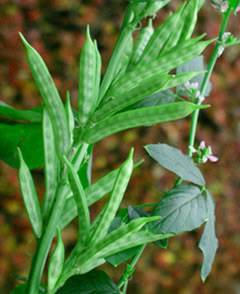Guar bean
| Guar bean | ||||||||||||
|---|---|---|---|---|---|---|---|---|---|---|---|---|

Guar bean, Cyamopsis tetragonolobus |
||||||||||||
| Systematics | ||||||||||||
|
||||||||||||
| Scientific name | ||||||||||||
| Cyamopsis tetragonolobus | ||||||||||||
| (L.) Deaf. |
The guar bean ( Cyamopsis tetragonolobus ), and guar called, is a useful plant from the family of legumes (Fabaceae or Leguminosae) subfamily Pea (Faboideae). It is closely related to a number of other crops called " beans " .
description
The guar bean reaches a height of up to two meters. The plant forms legumes about 10 cm long with oval seeds about 5 mm in size.
distribution
The guar bean probably originated in India, but maybe also in Central Africa. The main growing areas are in India and Pakistan . It may come from the wild plant Cyamopsis senegalensis .
use
The leaves and fresh pods are eaten as vegetables , the whole plant is used as green fodder . The dried seeds ("guar kernels") can also be eaten.
The most important product of the plant is the guar gum (also called guar , guar flour or guar gum ), which consists mainly of the multiple sugar guaran. The outer layers and the seedling are separated from the seed before it is ground. Guar gum is used as a thickener for a variety of foods (additive E 412). Similar food additives are gum arabic and carob gum from the seeds of the carob tree (see also vegetable gum ).
One technical application of guar gum is the production of thickeners for oil and gas extraction ( fracking ).
See also
literature
- Rakesh Pathak: Clusterbean: Physiology, Genetics, and Cultivation. Springer, Singapore 2015, ISBN 978-981-287-905-9 .
Web links
- Walter H. Schuster: Guarbohne (in: Legumes for grain use ) Justus Liebig University Giessen, 1998
- Isolated: plant genes for ice cream and Co ORF.at
- Udo Pollmer: Hunt for the miracle bean guar. There is a real thriller behind the designation E 412 Deutschlandradio Kultur, 23 September 2012
- Tamil Bean Bubble: How the US fracking boom is ruining Indian farmers. ZEIT ONLINE, January 2, 2013